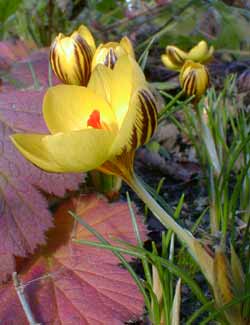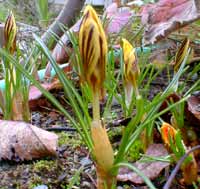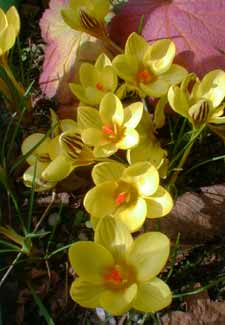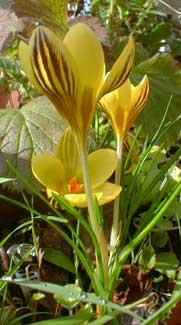
'Gypsy Girl'
Golden Crocus
"The gaudy crocus flaunts its pride,
And triumphs where its rival died."
-Mary Robinson
(1758-1800)
(1758-1800)
'Gypsy Girl' golden crocus was developed by Gerald H. Hageman of the International Flower Bulb Center (Internationaal Bloembollen Centrum) in Hillegom.
This drift of 'Gypsy Girl' is growing near the foot of a White Icicle Flowering Currant.
 They look very similar to another crocus we have growing under a young Pin Oak. It is ae called 'Fuscotinctus' but is not actually a cultivar; it is a clone of a natural variant of the species, C. chrysanthus var fuscotinctus, & seems to be a tiny bit more delicate than the nearly identical cultivar 'Gypsy Girl,' which has a slightly bigger flower & shorter grass, & established itself much more swiftly than has 'Fuscotinctus.'
They look very similar to another crocus we have growing under a young Pin Oak. It is ae called 'Fuscotinctus' but is not actually a cultivar; it is a clone of a natural variant of the species, C. chrysanthus var fuscotinctus, & seems to be a tiny bit more delicate than the nearly identical cultivar 'Gypsy Girl,' which has a slightly bigger flower & shorter grass, & established itself much more swiftly than has 'Fuscotinctus.' Another one which looks awfully similar is C. chrysanthus 'Goldilocks' but it starts its first blooms about two weeks later, extending the number of weeks that yellow crocuses are aglow.
Another one which looks awfully similar is C. chrysanthus 'Goldilocks' but it starts its first blooms about two weeks later, extending the number of weeks that yellow crocuses are aglow.The three-inch brilliantly yellow star-shaped blooms of 'Gypsy Girl' have on their outer petals red-bronzy or plum stripes, & the base of the blossom is greenish with red spots. When fully opened the inner petals are the most vibrant purest yellow, though the interior is a lighter shade than the other two earliest blooming yellows, C. koralkowii 'Kiss of Spring' & C. ancyrensis 'Golden Bunch.'
It is just about the strongest of the very early yellows, because if stormy weather comes along, 'Kiss of Spring' & 'Golden Bunch' are in some years quite soon battered down, but 'Gypsy Girl' pops back up when the sun returns.
 When this crocus has finished blooming & all that remains is the crocus-grass, there are, growing in the same general vicinity, numerous die-back perennials which are returning to take advantage of the vacated space, keeping the location lively. There is also an extensive drift of C. tommasinianus 'Ruby Giant' nearby, so that as the yellows are fading, the bright blue-purple tommies are arriving.
When this crocus has finished blooming & all that remains is the crocus-grass, there are, growing in the same general vicinity, numerous die-back perennials which are returning to take advantage of the vacated space, keeping the location lively. There is also an extensive drift of C. tommasinianus 'Ruby Giant' nearby, so that as the yellows are fading, the bright blue-purple tommies are arriving.'Gypsy Girl' likes full sun, but will get by in partial shade. It naturalizes with great ease. The first year in the ground they bloomed in February, & were in bright full bud the third week in January.
But for their second, they were in full bud by mid-January & in full flower well before the end of the month. In their third year, they were a couple blooms shining bright at mid-January & the drift was in full form by the third week of January.
The first two portraits on this page are from January 2004, the third from the beginning of February. The second photo shows the bud-like appearance of how they look on overcast days when they are apt to remain closed, & the other two snapshots show what they look like on sun-shiny days. The fourth photo from January 2005 shows how striking is the plum feathering.
That pinkish red leaf intruding in the open-bloom portrait at the top of this page is Geum quellyon var flora plena 'Blazing Sunset.' The nearly evergreen leaves are bright green throughout autumn & much of winter, then toward winter's end turn this lovely color.